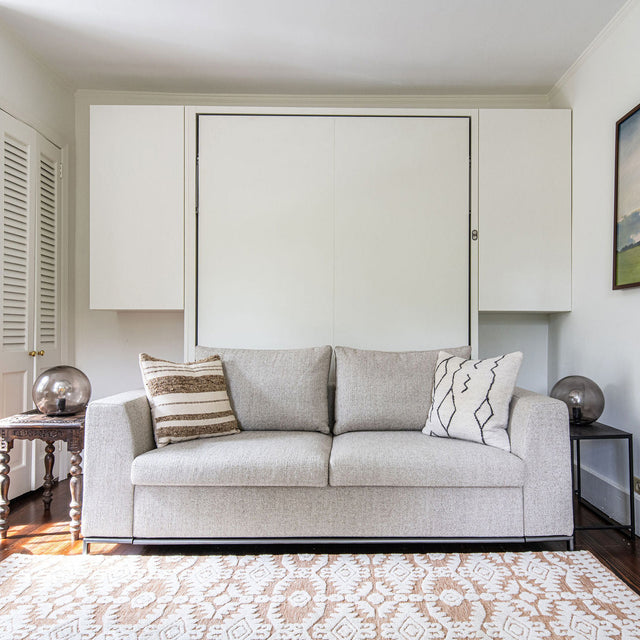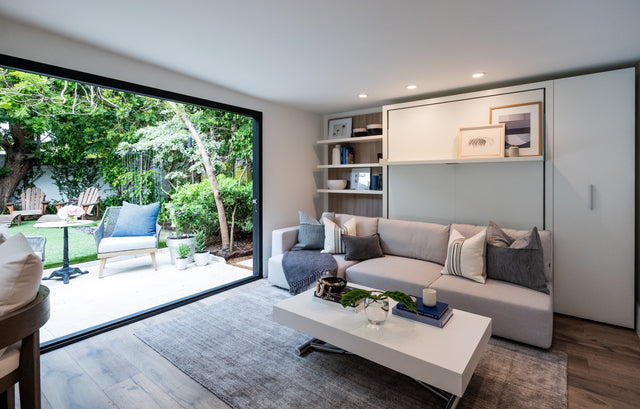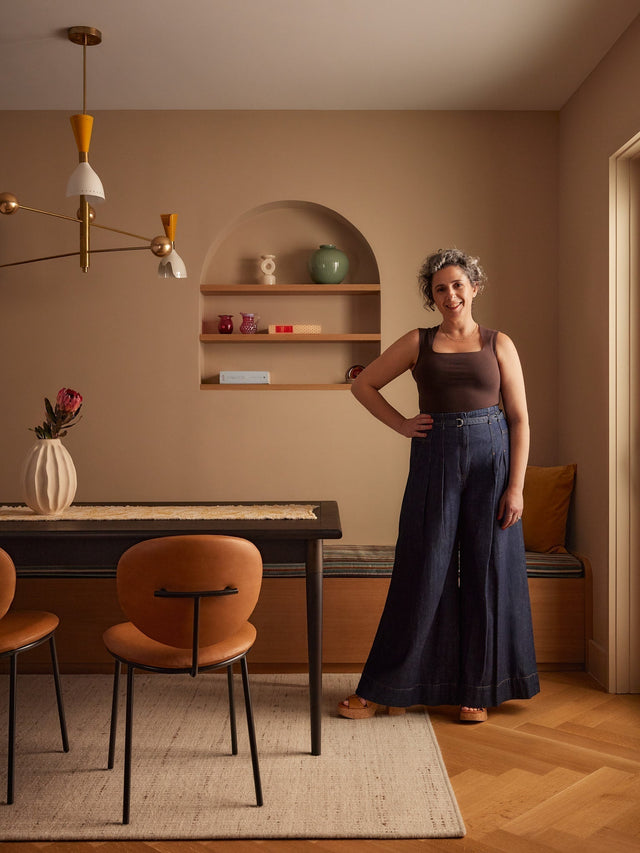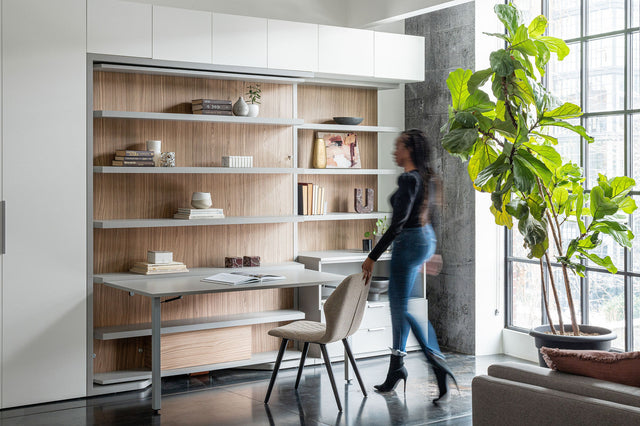Quality, from the Inside Out
Our Pursuit of Perfection
At Resource Furniture, we believe that good design should enrich life—for you, your home, and the planet. Our transforming systems help create multifunctional spaces, enabling more elegant and efficient living in less square footage. By allowing a single room to serve multiple purposes, we reduce the need to build, heat, and power additional space, significantly lowering the environmental impact.
Our collection of space-saving, Italian-crafted furniture empowers you to design with intelligence, elegance, and purpose. Whether it is a Murphy bed with desk or a Murphy bed with couch, these multifunctional pieces provide the flexibility to optimize every inch.
True sustainability encompasses more than spatial efficiency—it involves a holistic approach to sourcing, craftsmanship, and environmental responsibility. We take pride in every step of the process, prioritizing superior material quality, ethical manufacturing, and enduring design.
Why Knockoffs Fall Short
While mass-market Murphy bed alternatives may imitate our aesthetic, they seldom meet the rigorous environmental, safety, and quality benchmarks we uphold. Their supply chains are opaque, favoring cost and speed over transparency, durability, and ethical labor. These compromises come at a cost—to the planet, to workers, and ultimately, to the discerning customer.
At Resource Furniture, we hold ourselves—and our products—to a higher standard, because our clients, our craftspeople, and our planet deserve nothing less.
Superior Material Quality & Sourcing
Sustainable furniture begins with responsible sourcing. Our premium Italian-made Murphy beds are constructed using composite wood panels that contain a minimum of 90% recycled and reforested wood. No trees are felled in the production process. Instead, we divert thousands of tons of post-consumer and post-industrial waste from landfills. Learn how to evaluate sustainable furniture beyond the surface level.
“Composite wood is lighter than solid wood, which makes it easier and more efficient to ship globally,” says Resource co-founder Ron Barth. “And because our Murphy bed mechanisms rely on patented systems, the material must remain dimensionally stable. Composite wood holds its shape and resists warping, ensuring flawless function for years.”
Even our new chipboard panels are sourced from renewable virgin wood, certified E1 or better. These panels reduce waste by 35%, lower energy consumption, and are entirely free of added formaldehyde.
Formaldehyde-Free & VOC-Safe
Each Resource Furniture product meets or exceeds CARB2 and TSCA Title VI standards—the highest benchmarks for formaldehyde emissions.
“That ‘new furniture smell’ is actually off-gassing—the release of volatile organic compounds that degrade indoor air quality,” Barth notes. “In our showrooms, there is no such odor because our furniture contains no VOCs and is finished exclusively with water-based lacquers, paints, and glues.”
In compact spaces, indoor air quality becomes all the more critical. Our zero-VOC finishes safeguard both your health and the environment. Explore our low-impact fabric innovations in the Aquaclean collection.
Cleaner, Greener Manufacturing
Our manufacturing partners exceed industry norms through advanced processes that capture and recycle particulate and gas by-products at every stage.
For instance, CLEI—our exclusive wall bed manufacturer—cuts and seals composite panels in vacuum chambers, capturing sawdust and preventing emissions. Even gases released during laser edge-banding are contained and recycled via specialized partners.
This meticulous approach is rare—and it is visible in every seamless edge, every panel alignment, and every flawless finish.
Patented Performance
Each CLEI Murphy bed is an original, patented design—right down to its hidden, precision-engineered mechanisms. While others rely on off-the-shelf components, CLEI designs every part in-house and tests each mechanism according to ISO 9001 standards.
“Most companies buy generic hardware,” Barth explains. “CLEI engineers their own. The result is a cleaner silhouette, superior performance, and uncompromising safety.”

Every Murphy bed mechanism is subjected to over 10,000 open-close cycles to guarantee decades of flawless use. This is why we confidently offer a lifetime warranty.
Built to Last, Backed for Life
Our products are not disposable. They are crafted to outlast trends, relocations, and renovations.
As proof, consider the Colombo family—founders of CLEI—who still use their original 1970s LGM wall bed in their summer residence. From Florida to the Caribbean to South America, our furnishings perform in diverse climates with zero delamination or degradation.
Thanks to their modular design, individual components can be replaced as needed, reducing waste and extending product life.
Whether you choose a queen Murphy bed, a Murphy bed with desk, or Murphy bunk beds, each piece exemplifies timeless durability.
Supply Chain Transparency
Our manufacturing partners are based exclusively in Europe and are carefully vetted to ensure compliance with the highest labor and human rights standards. Employees enjoy fair wages, healthcare, and paid leave—benefits we consider fundamental.
“We know our makers personally,” says Barth. “They are valued, highly skilled professionals. This commitment to quality extends beyond materials—it is embedded in every relationship.”
Our People-First Promise
This same ethic guides our internal culture. As a small business, we provide comprehensive benefits, including healthcare, profit-sharing, and retirement programs. We invest in our team because we believe that great design is only possible through empowered, supported people.
From material sourcing to customer support, every choice we make is intentional. It reflects our belief that the quality of a life is not measured in square feet. It is about living a big life with a minimal impact.
Ready to Transform Your Space?
From responsibly sourced materials to precision engineering, every aspect of our furniture is designed with purpose. We believe your home should reflect your values—where style, sustainability, and innovation live in perfect harmony.
Whether you are maximizing space in an urban apartment, designing a multi-use guest room, or simply seeking a healthier, more sustainable living environment, Resource Furniture offers solutions that elevate your lifestyle without compromise.
We invite you to experience this commitment in person.
Popular posts

Aging in Place That Actually Feels Like Home

Does Converting a Garage to a Living Space Add Value? What to Know Before You Start

Multifunctional Kids' Room by YZDA at Armani Casa Miami

When Every Inch Counts: A Multifunctional Retreat in Cobble Hill
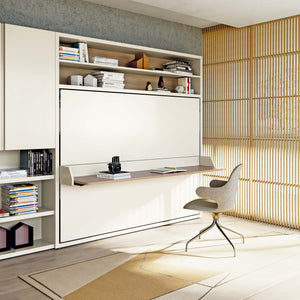
10 Bonus Room Ideas: What To Do With Your Extra Space






